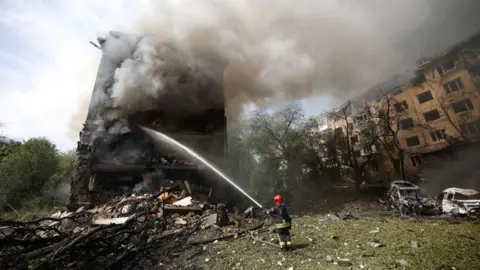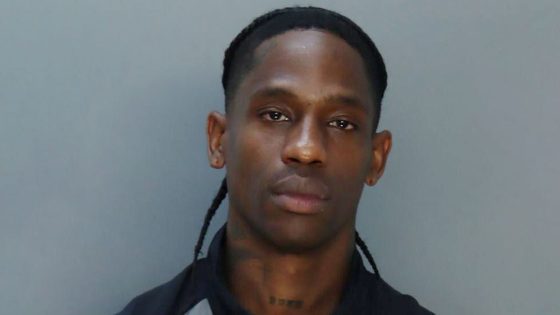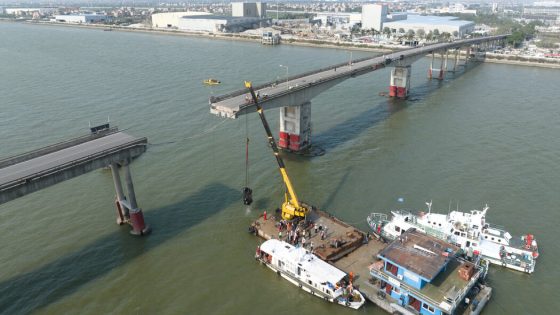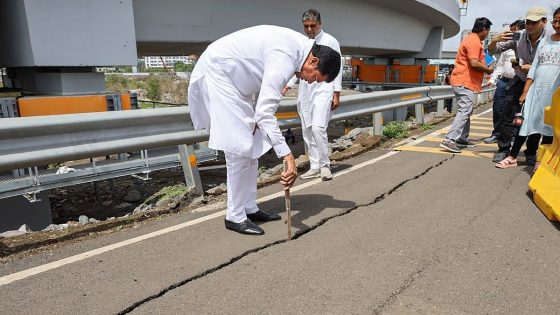By Tom Bateman, BBC State Department correspondent
 AFP
AFPOnly one US president has been at the Nato summit in Washington this week, but the shadow of another – his predecessor – has loomed over this meeting of the world’s most powerful military alliance.
While the host Joe Biden has presided over a message of unity from the group’s 32 members, the Nato-sceptic views of his rival for power, Donald Trump, have imbued conversations here with an urgency and an anxiety.
At times the smiles from world leaders in the conference hall have felt fragile. Trump “hangs over every conversation here”, said one Eastern European diplomat who asked to remain nameless.
The Republican’s election as president in November “could change everything”, the diplomat said. The fact that Mr Biden has been trying to fend off a political crisis over his frailty has only sharpened the sense that a second Trump term could bring far-reaching changes to an alliance forged in the ashes of the World War Two and still reliant on hard US military power to deter adversaries.
So does Nato need to “Trump-proof” itself – as some describe it – and if so, is it possible?
There is a lot of evidence of efforts by Nato allies to reach out already to those in Trump’s political orbit to try to manage relationships and limit what they would see as the potential damage of a second term. But others suggest something more unmanageable.
Camille Grand, a French former official who was one of Nato’s deputy leaders throughout the Trump administration, described himself as “much more worried” than colleagues who think a second term may be “Trump [term] one on steroids” but ultimately workable for the alliance.
“He doesn’t have the same sort of guardrails, he doesn’t have the same sort of adults in the room. And he has around him a team that is trying to turn his instinct into policy,” said Mr Grand, who is now a fellow at the European Council on Foreign Relations.
Four members of visiting delegations, who asked to remain anonymous, told the BBC their concern was not necessarily that a Trump administration would withdraw entirely from Nato, as he has threatened before.
Rather it is a fear that the US commitment to the alliance’s core principle of collective security – “all for one and one for all”, meaning any ally under attack can expect defence from the others – could wane.
Trump’s positions on Nato have veered erratically from outright hostility – portraying the alliance as a bunch of freeloading Europeans surviving off protection paid for by US taxpayers – to suggesting his outbursts are simply part of a cunning negotiating tactic to compel more of Nato’s members to meet its defence spending targets.
He has frequently tried to rally crowds of supporters with attacks on the organisation. As the summit began, he posted to his Truth Social network that when he started as president most Nato members were “delinquent” until they “paid up” due to his pressure.

By the end of Trump’s presidency, four more Nato countries had hit the alliance’s guidelines of spending at least 2% of national income on defence. So far during President Biden’s term, another 13 countries have reached the target.
That progress is frequently touted by the Biden administration and its backers, although in reality much of the increase was triggered by Russia’s full-scale invasion of Ukraine.
At a February campaign rally in South Carolina, Trump said he would let Russia “do whatever the hell they want” to Nato countries that did not spend enough.
That sparked outrage from some quarters in Washington, but privately his threats are said to have gone further.
At a panel event in January, European Union commissioner Thierry Breton described a meeting he had attended in 2020 between Trump and European Commission President Ursula von der Leyen.
“Donald Trump said to Ursula: ‘You need to understand that if Europe is under attack, we will never come to help you and to support you. And by the way, Nato is dead. And we will leave, we will quit Nato.’
“It was the president of the United States of America,” recalled Mr Breton. “He may come back.”

Trump’s campaign has been approached by the BBC with a request to confirm whether the account was accurate. Evelyn Farkas, a former senior official at the Pentagon in the Obama administration, believes there remains a real concern even over Nato’s existence under Mr Trump.
“I think there is a danger with Trump that he tries to pull us out of Nato. I won’t sugarcoat that,” said Dr Farkas, now executive director at public policy think tank the McCain Institute.
“The reality is Trump is dangerous to the alliance in that America is still the strongest economic, political, military power and Nato is stronger if Nato has the United States inside the alliance.”
But one of those familiar with the thinking in Trump’s political orbit, Dan Caldwell from the right-wing think tank Defence Priorities, believes the former president’s priority it to push European nations to invest more in their own militaries.
“I don’t think he wants to withdraw from Nato, but he has said that the United States should re-evaluate its role and the purpose of Nato going forward,” he said.
“Not only the former president but more and more national security experts on the right believe the United States has really no choice but to do less in Europe. So I think that there’s some larger forces at play, that will eventually force the next president, regardless of who it is… to substantially pull back from Nato.”
The most detailed account of policy positions that might influence a second Trump term comes from an initiative being brought up by supporters and detractors of Trump alike. Overseen by the conservative Heritage Foundation, “Project 2025” is a 900-page detailed blueprint for a Republican president to usher in a sweeping overhaul of the executive branch.
 Getty Images
Getty ImagesThe initiative says a future president should “transform Nato” so that America’s role is primarily for its nuclear deterrent, while other members should field “the great majority” of conventional forces required to deter Russia.
This is in keeping with the project’s foreign policy position, seeing the main threat to US primacy as China and therefore calling for the next president to “bring resolution to the foreign policy tensions” sparked by Russia’s 2022 invasion of Ukraine.
Trump himself has equivocated over the war but has said he would end it in “24 hours”. He favours brokering a deal between Russia and Ukraine on terms that many Nato allies would see as surrender for Kyiv.
Trump has partially disavowed the initiative, saying he does not know who is behind it but many of his former officials had a hand in writing it, including a former defense secretary.
Since Trump left office, the increases in the number of Nato members spending at least 2% of income on defence better insulates the alliance for the future, said Senator Chris Coons, a Democrat who sits on the Senate Foreign Relations Committee.
Asked about “Trump-proofing”, he said Congress had also better shielded America’s membership of Nato from the whims of the White House, in a law passed last year. “We clarified no president can unilaterally withdraw from Nato without a vote of approval from the Senate,” Mr Coons told the BBC.

More on the US election

He also highlighted the $60bn military assistance package for Ukraine finally passed in April in a bipartisan effort following nine months of paralysis, after allies of Trump blocked passage of the bill through Congress.
“It is my hope that we will continue to be a counterweight and a counterbalance to the president should we, I think, make the tragic mistake of moving forward with a second Trump term.”
But Trump has repeatedly challenged current levels of US military provision for Ukraine, again arguing he could negotiate the war’s end with Russia.
Another possible attempt to future-proof US support for Ukraine is by moving more co-ordination for arms supply to Nato itself – taking it further out of reach of a future American president. Such a move has been pitched by Nato Secretary General Jens Stoltenberg as a way to “shield” Ukraine’s supply of aid “against the winds of political change”, officials told The Financial Times.
At the summit the alliance agreed to launch a new program in which Nato will supplement, but not replace, a 50-nation “contact group” that co-ordinates delivery of weapons. Camille Grand, the former Nato official, thinks the summit may have “raised the cost” for a future President Trump to roll back the “messaging” from Nato, but in the end, he said, Trump-proofing was impossible.
“If the US, as the biggest shareholder in the alliance, decides to be tough on the alliance, on Ukraine, there is no nothing in the [summit agreement] and previous summits that prevent it from doing that.
“But I think it’s sending an important message to Trump and his team, which is that the Europeans have turned the corner when it comes to [increased] spending.”
Czech Foreign Minister Jan Lipavský reiterated that, telling me that any future president of the US that wanted to change things on Nato had the power to do so.
The real work of “Trump-proofing” at this summit has instead felt like Nato supporters pitching the alliance to conservative Americans to try to change their view. This found its most striking moment when President Zelensky appeared at the Reagan Institute for an on-stage conversation with Fox News host Bret Baier.
Mr Zelensky repeatedly raised the memory of the late Republican President Ronald Reagan, quoting Cold War lines on deterring enemies through working with allies.
Reagan is a favoured reference for Democrats trying to expose Republican divisions and what they see as the maverick isolationism of Trump. The subtext is: Reagan would turn in his grave at Trump’s Nato-sceptic stance. But it’s a message that may fall flat with those who Zelensky thinks need to hear it.
Source Agencies





